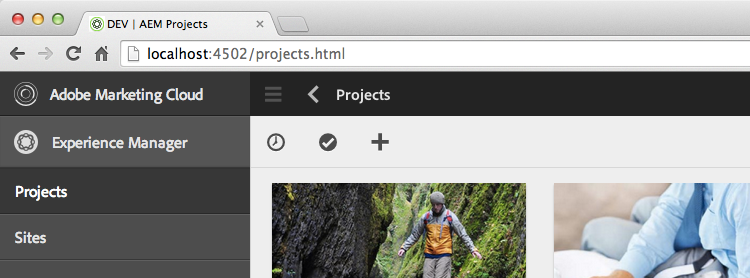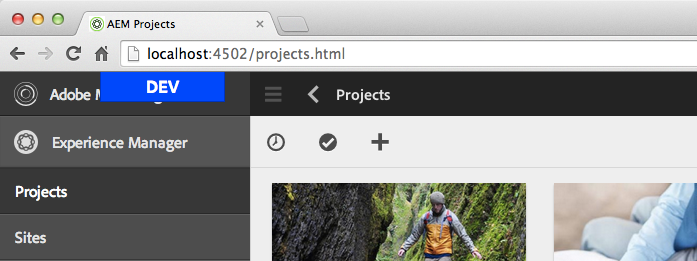Purpose
When working with AEM it’s common to be accessing multiple environments in the same browser, making it confusing as to which environmental changes are being made to.
How to Use

Define a sling:OsgiConfig with the following attributes. <?xml version="1.0" encoding="UTF-8"?>
<jcr:root xmlns:sling="http://sling.apache.org/jcr/sling/1.0" xmlns:cq="http://www.day.com/jcr/cq/1.0" xmlns:jcr="http://www.jcp.org/jcr/1.0" xmlns:nt="http://www.jcp.org/jcr/nt/1.0"
jcr:primaryType="sling:OsgiConfig"
css-color="orange"
css-override="#acs-commons-env-indicator { .. }"
inner-html=".."
browser-title-prefix="Dev"
/>
css-color: The color of the indicator bar; Accepts any valid value for the CSS background-color attribute. Ignored if css-override is set.
css-override: CSS to style the indicator div. All styles should be scoped to #acs-commons-env-indicator { }
inner-html: Any valid HTML (or text) that will be added inside the indicator div.
browser-title-prefix: The value to prefix the browser title with.
Indicators
Browser Title

Set a value in the browser tab using the browser-title-prefix sling:OsgiConfig property. This value will display in the browser title in the format <browser-title-prefix> | <original-browser-title> for example: DEV | AEM Projects
Browser titles can be used in conjunction with visual indicators (bars, tabs or other custom)
AEM Indicator Bar

The bar is a default visual indicator. This indicator can be configured using the css-color property. Accepts any valid value for the CSS background-color attribute.
Custom AEM Indicator
Custom indicators can be added using the css-override and inner-html properties.
Remember to escape the value of inner-html and css-override as needed using escapehtmlforxml.com
css-override selectors should always be scoped w #acs-commons-env-indicator
The base indicator div is injected at the end of the document like so ... <div id="acs-commons-env-indicator"></div></body> and thus should be positioned using fixed or absolute positioning.
fixed positioning is usually better so the indicator is not lost when scrolling the page
The z-index for #acs-commons-env-indicator should be very high as to not be hidden by overlapping elements.
Image stylings should be added as data URIs. (Data URI Maker)
System Properties in inner-html (Since v2.2.0)
Since v2.2.0, System Properties can be injected into a templatized inner-html.
Example: inner-html="<div>${os.name} - ${os.version}$</div>" would inject the OS Name and Version.
Note: HTML escaping considerations still need to be followed as noted above.
Custom Example: AEM Indicator Tab
This is an example of a custom indicator that renders the environment name in a fixed “tab” in the upper left corner of the browser window.

Set css-override to with adjusted color and background colors per environment. #acs-commons-env-indicator {
background-color: #800080;
color: #FFF;
position: fixed;
top: 0;
left: 50%;
width: 126px;
margin-left: -63px;
height: 30px;
font: bold 18px/29px sans-serif;
text-align: center;
border: solid 1px black;
border-top-width: 0;
z-index: 100000000000000;
}
Set inner-html to be the text to display; Ex. “Local”, “Dev”, “QA” or “Staging”
You can even add JS to the inner-html make the Tab move away from your mouse Local
<script>
document.getElementById('acs-commons-env-indicator').onmouseover = function() {
if(this.style.left === '50%') {
this.style.left = '25%';
} else {
this.style.left = '50%';
}
};
</script>
Source: https://adobe-consulting-services.github.io/acs-aem-commons/features/environment-indicator/index.html
No comments:
Post a Comment
If you have any doubts or questions, please let us know.